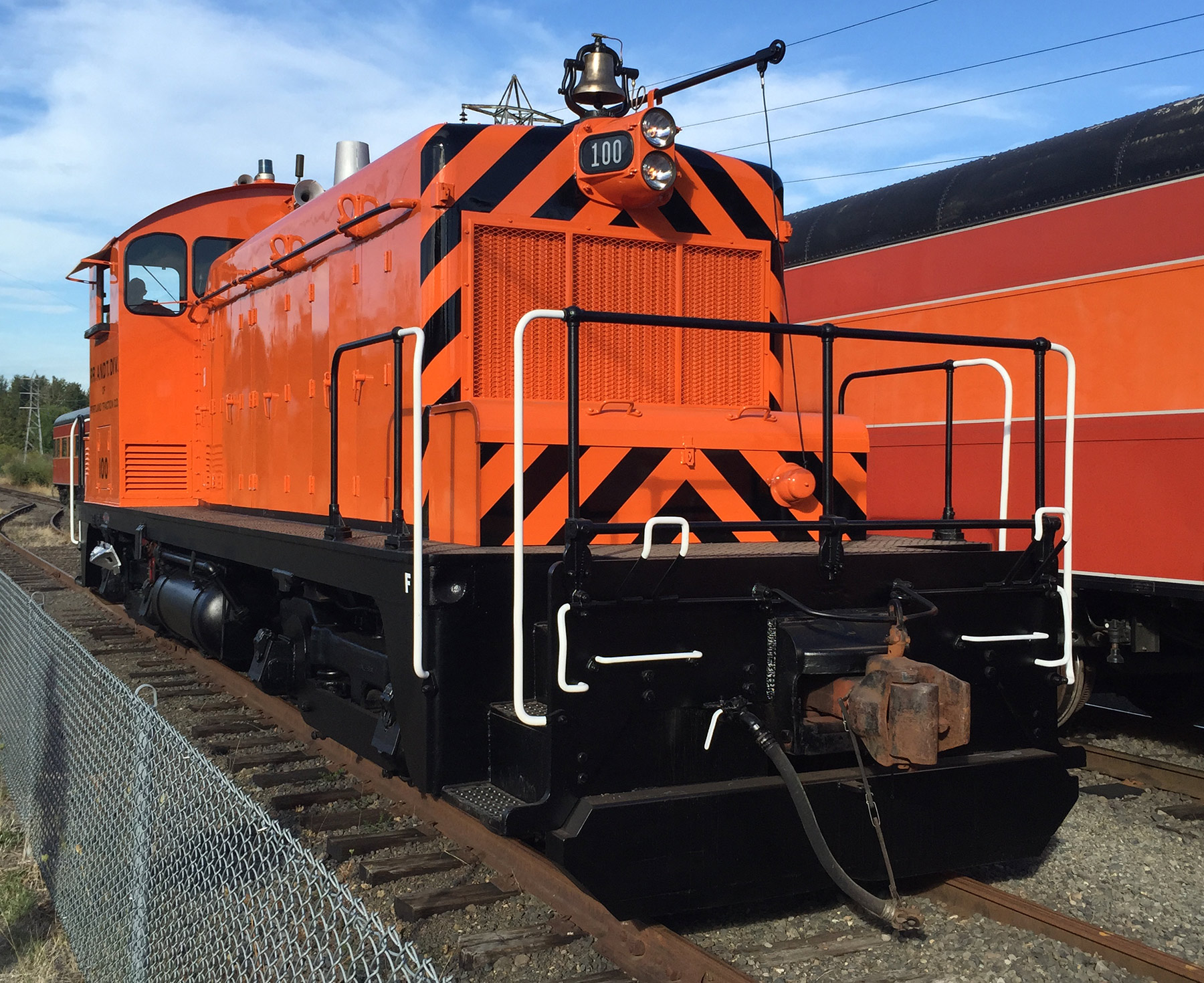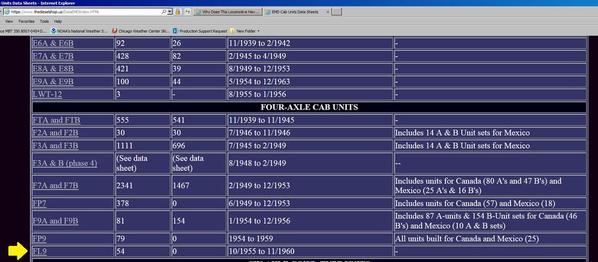
Replies sorted oldest to newest
No picture makes it hard..........
So it could also operate off the overhead trolly wire?
The locomotive was owned by a traction company (Pacific Electric???) The poles are used to activate the signaling system.
Rusty
Rusty Traque posted:The locomotive was owned by a traction company (Pacific Electric???) The poles are used to activate the signaling system.
Rusty
Right. Portland Traction Co. Try Googling that, for more information.
I just read about the trolley pole's purpose. I'm assuming that because the electric power had been retired, the catenary wire was dead. So the locomotive operated under its own power, and the trolley pole activated crossing signals. Very interesting operation.
If the catenary wires were dead, the signals wouldn't work.
Generally a diesel with a trolley pole means an electric railroad has bought a diesel or diesels, and added the poles so when the diesel is working in electrified areas, it trips the block signals. Some electric railroads found it easier / more economical to have diesels that could go say switch industries or interchanges with other railroad, since the electric railroad then didn't have to build and maintain the overhead wiring for those operations.
Normally the diesels wouldn't have a way to be powered by the overhead wire, although New York Central and the New Haven had diesels that could be powered by either their own internal diesel-electric power, or by straight electricity via the third rail.
The NYC didn't have any dual mode diesels I'm aware of. The New Haven was the only buyer of the FL9.
Rusty
Rusty Traque posted:The NYC didn't have any dual mode diesels I'm aware of. The New Haven was the only buyer of the FL9.
Rusty
What about on the Hudson Line?
That's one of the locomotives that pulled 4449 out of Oaks' Park in 1974 for it's restoration for the Freedom Train. They had trolley poles then:

WSTIX is right. The trolley pole would only be able to activate signals in territory where overhead wire was energized and where the signal circuit required it.
I grew up in Brea, California, on the Pacific Electric Yorba Linda line. In the late 1940's and although we had no overhead wire in the late 1940's and early 1950's, regular motive power on our daily local freight was a Baldwin VO switcher with a trolley pole mounted on the top of the hood. PE de-electrified the line from Whittier Jct. to Yorba Linda during World War II and either re-used the wire or sold it, as copper was needed by the war effort. They changed the signal circuits for the handful of wigwag crossing signals to a conventional track circuit east of Whittier Jct. When electric passenger service to Whittier was discontinued in the early 50's, there was no longer any need for trolley pole diesels on the Yorba Linda Line.
Railfan Brody posted:Rusty Traque posted:The NYC didn't have any dual mode diesels I'm aware of. The New Haven was the only buyer of the FL9.
Rusty
What about on the Hudson Line?
Nope.
The FL9 was the only dual mode diesel locomotive made for the domestic market. 54 were built and only the New Haven bought them.
There's one or two preserved in NYC paint, but they are ex-New Haven-->PC units with a fantasy/heritage NYC paint job.
(OK, I'll admit I didn't know anything about NYC's tri-power locomotives. From what I can find on a quick search, they seemed confined to freight service in Manhattan. Somebody with access to Stauffer's NYC Power book could probably fill us in...)
Rusty
p51 posted:I've driven around a lot of the area that loco operates in and I don't recall ever seeing any overhead wires...
That's because the Portland Traction Company, and its overhead trolly wires are LONG GONE!
Their contact info is on this website if you really want to know.
Rusty Traque posted:Railfan Brody posted:Rusty Traque posted:The NYC didn't have any dual mode diesels I'm aware of. The New Haven was the only buyer of the FL9.
Rusty
What about on the Hudson Line?
Nope.
The FL9 was the only dual mode diesel locomotive made for the domestic market. 54 were built and only the New Haven bought them.
There's one or two preserved in NYC paint, but they are ex-New Haven-->PC units with a fantasy/heritage NYC paint job.
(OK, I'll admit I didn't know anything about NYC's tri-power locomotives. From what I can find on a quick search, they seemed confined to freight service in Manhattan. Somebody with access to Stauffer's NYC Power book could probably fill us in...)
Rusty
The New York Central actually tested the FL9's on the Harlem Division, but apparently was not impressed.
Ironically, under Penn Central/Conrail/MTA/Metro-North control, they often operated over the Harlem and Hudson Divisions.
In the 1990's, I would get out of work at 5pm, drive south to pick up my wife at 6pm in Scarsdale. Her job was with walking distance of Scarsdale station, on the Harlem Division. While I waited for her, I would mosey over to the station... between 5:45 and 5:50pm on weekdays, a northbound express train would storm through Scarsdale, for several years powered by double-headed FL9's. Quite an impressive sight.
Tom
At the time the pole(s) was put on this locomotive it was to activate signals. That was the purpose it was put on there. Matt
645 posted:Rusty Traque posted:Railfan Brody posted:Rusty Traque posted:The NYC didn't have any dual mode diesels I'm aware of. The New Haven was the only buyer of the FL9.
Rusty
What about on the Hudson Line?
Nope.
The FL9 was the only dual mode diesel locomotive made for the domestic market. 54 were built and only the New Haven bought them.
There's one or two preserved in NYC paint, but they are ex-New Haven-->PC units with a fantasy/heritage NYC paint job.
(OK, I'll admit I didn't know anything about NYC's tri-power locomotives. From what I can find on a quick search, they seemed confined to freight service in Manhattan. Somebody with access to Stauffer's NYC Power book could probably fill us in...)
Rusty
Don't know where you are getting your information but there were sixty FL9's built - New Haven 2000-2059 - not 54!
https://en.wikipedia.org/wiki/EMD_FL9
Looks like six FL9's were preserved if this list is accurate: http://www.thedieselshop.us/PRSVDemdFs.HTML
This list of surviving New Haven equipment may be more accurate: http://www.nhrhta.org/htdocs/surviving_mp.htm
CDOT/NH 2019 right now is the best preserved and operational example:
As for the NYC tri-power locomotives I did say they were mainly used on the West Side Line - however did not clarify that line is in Manhattan in case you are not familiar with New York Central and their New York City trackage.
A quick check from The Diesel Shop:
which I guess is proof not everything on the internet is true (shocking, I know,) in spite of good intentions. I was wrong. Big deal. It happens. I try not to push blatant inaccuracies.
It still doesn't change the fact that the FL9 was purchased exclusively by the New Haven.
Rusty
Attachments
And I may also add the the Lackawanna had 2 or more Diesel/Electric/Battery locos. Their primary use was transfer runs between Jersey City/Hoboken and Harrison yards. (The electric was 2500 VDC catenary used by the "Edison" MU's.)
The NYC tri-power boxcabs look very cool. Has this ever been done in O Gauge? (I don't think I've ever seen it from Lionel or MTH.)







